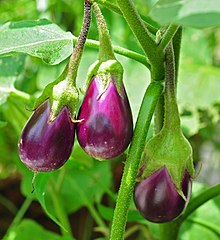| Eggplant | |
|---|---|

| |
| The fruit developing on the plant | |
| Scientific classification | |
| Kingdom: | Plantae |
| Clade: | Tracheophytes |
| Clade: | Angiosperms |
| Clade: | Eudicots |
| Clade: | Asterids |
| Order: | Solanales |
| Family: | Solanaceae |
| Genus: | Solanum |
| Subgenus: | Solanum subg. Leptostemonum |
| Section: | Solanum sect. Melongena |
| Species: | S. melongena
|
| Binomial name | |
| Solanum melongena | |
| Synonyms | |
|
Solanum ovigerum Dunal | |
Eggplant (US, CA, AU, NZ, PH), aubergine (UK,[1] IE), brinjal (IN, SG, MY, ZA), or baigan (IN, GY)[2][3] is a plant species in the nightshade family Solanaceae. Solanum melongena is grown worldwide for its edible fruit.
Most commonly purple, the spongy, absorbent fruit is used in several cuisines. Typically used as a vegetable in cooking, it is a berry by botanical definition. As a member of the genus Solanum, it is related to the tomato, chili pepper, and potato, although those are of the New World while the eggplant is of the Old World. Like the tomato, its skin and seeds can be eaten, but it is usually eaten cooked. Eggplant is nutritionally low in macronutrient and micronutrient content, but the capability of the fruit to absorb oils and flavors into its flesh through cooking expands its use in the culinary arts.
It was originally domesticated from the wild nightshade species thorn or bitter apple, S. incanum,[4][5][6] probably with two independent domestications: one in South Asia, and one in East Asia.[7] In 2021, world production of eggplants was 59 million tonnes, with China and India combined accounting for 86% of the total.
- ^ "Aubergine", Oxford English Dictionary, undated Archived 2015-08-10 at the Wayback Machine. Retrieved: 7 August 2015.
- ^ "Oxford Dictionary, s.v. brinjal". Oxford University Press. Archived from the original on 1 April 2016. Retrieved 4 April 2016.
- ^ "Etymology of the Eggplant". 21 June 2005.
- ^ Tsao and Lo in "Vegetables: Types and Biology". Handbook of Food Science, Technology, and Engineering by Yiu H. Hui (2006). CRC Press. ISBN 1-57444-551-0.
- ^ Doijode, S. D. (2001). Seed storage of horticultural crops (pp 157). Haworth Press: ISBN 1-56022-901-2
- ^ Doganlar, Sami; Frary, Anne; Daunay, Marie-Christine; Lester, Richard N.; Tanksley, Steven D. (1 August 2002). "A Comparative Genetic Linkage Map of Eggplant (Solanum melongena) and Its Implications for Genome Evolution in the Solanaceae". Genetics. 161 (4): 1697–1711. doi:10.1093/genetics/161.4.1697. PMC 1462225. PMID 12196412. Archived from the original on 11 March 2016. Retrieved 3 August 2012 – via www.genetics.org.
- ^ "Solanum melongena". Germplasm Resources Information Network. Agricultural Research Service, United States Department of Agriculture. Retrieved 20 November 2014.